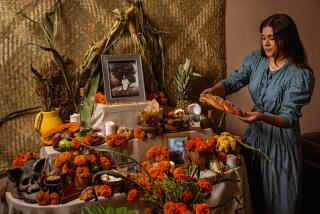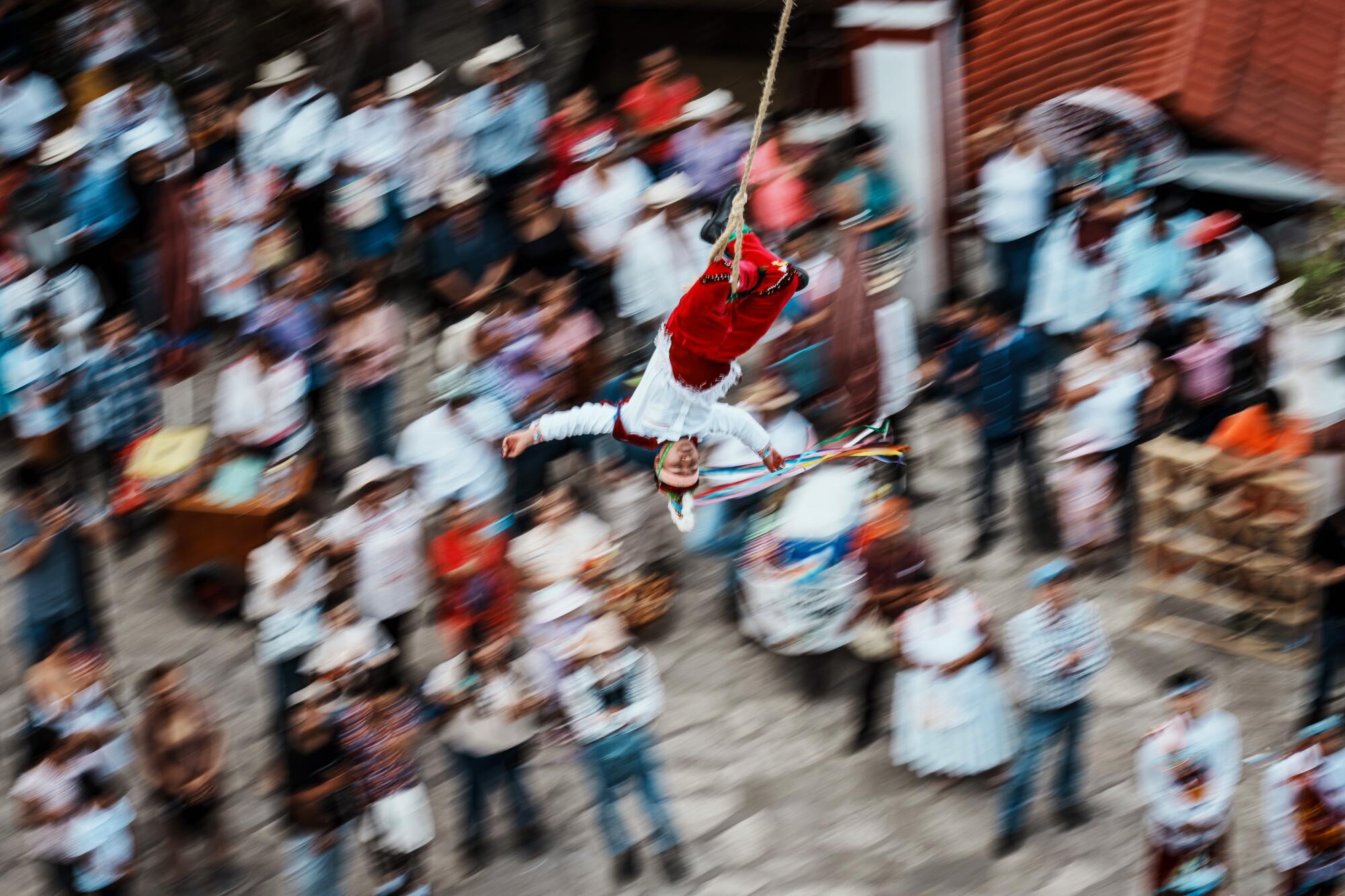
CUETZALAN, MEXICO — Ricardo García kneels before the towering tree in the middle of town and, like his brothers and father before him, prepares for a journey taking him 100 feet up and 2,500 years into the past.
He places one foot on a wooden step nailed into the spine of the tree trunk shorn of branches. He hoists himself up, a hand on one plank, then another. Wind ruffles the gold fringe at the hems of his red pants and the feathers on his headdress as he climbs with no safety harness.
At the top, almost parallel with the bells of the church tower, he sits alongside three other voladores — fliers — on a square, mounted frame. He ties a thick rope that’s attached to the trunk around his waist. People in the square below lift their faces to watch.
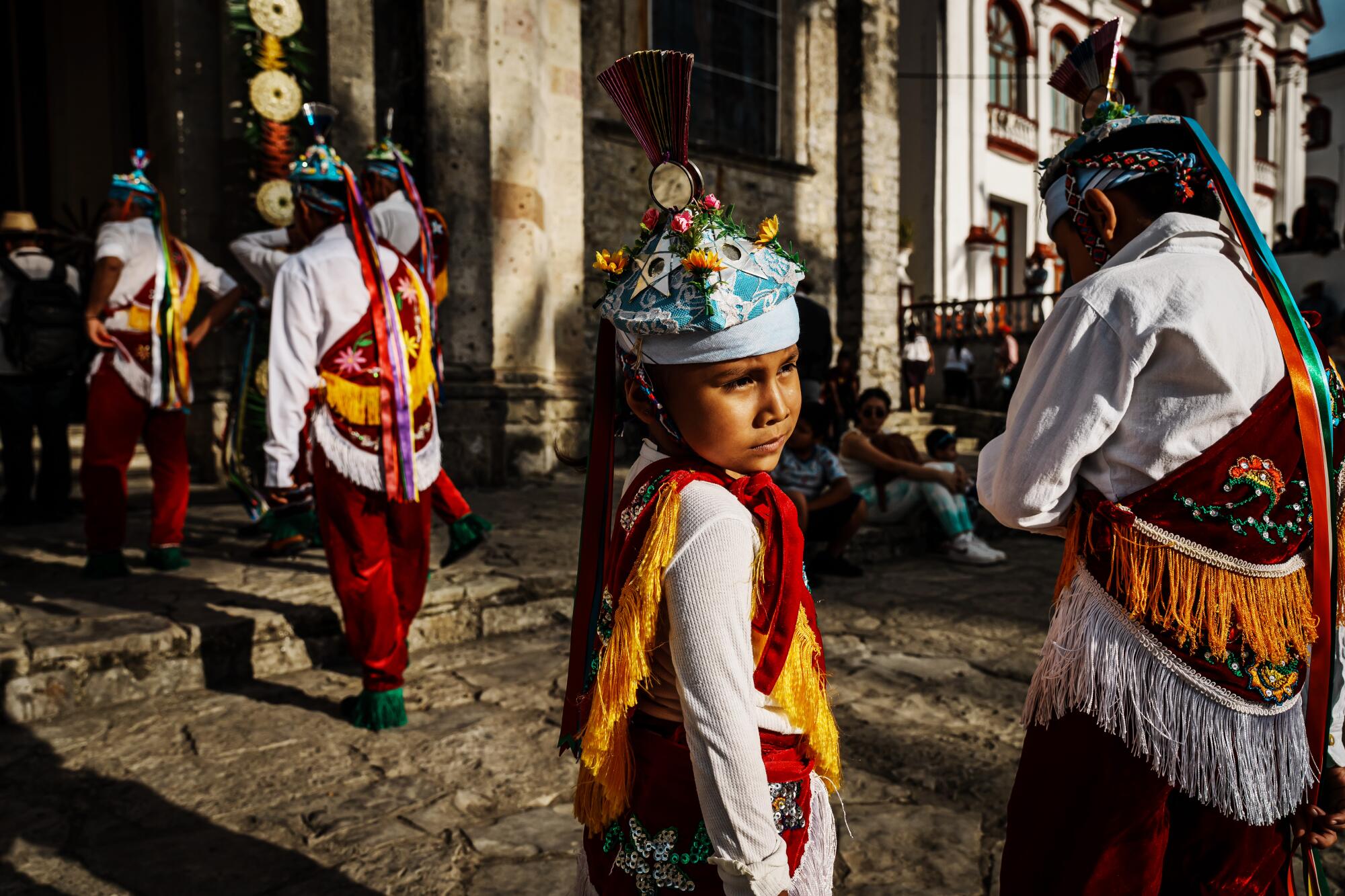
Ricardo, 25, has been making this climb since he was 15 and his chest “cold” with nerves. For years, as a child, he had watched with envy as his two brothers took part in ceremonies central to the identity of this town and its people.
Now, he sits with his legs dangling, taking in the church’s spire, the spectators below, the cluster of houses giving way to central Mexico’s lush green mountains. Ricardo hears the whistling of a flute and the beat of a drum played by a fifth volador stomping inches away at the top of the trunk, his back arched and face tilted toward the sky.
Then on the count of three, Ricardo and three others lean backward to fall headfirst into nothing.
::
Across Mexico, hundreds of people take to the skies this way, spiraling gently to the ground and preserving an Indigenous tradition that survived the Spanish conquistadors perhaps simply because it is jaw-dropping.
For generations, families like Ricardo’s have taken it upon themselves to keep alive what started as a plea to the gods for rain and good crops. Now the Ritual Ceremony of the Voladores, as it’s officially known, is performed for all sorts of occasions, including holidays and festivals to honor Catholic saints.
Along with passing the ceremony down to their children, the voladores are fighting to provide it legal protections and figuring out how to keep the ritual pure while collecting tips from tourists.
For Ricardo, who ekes out a living as a motorcycle mechanic, the meaning outweighs the risk. He’s been flying for 10 years and the ritual retains its magic.
1

2
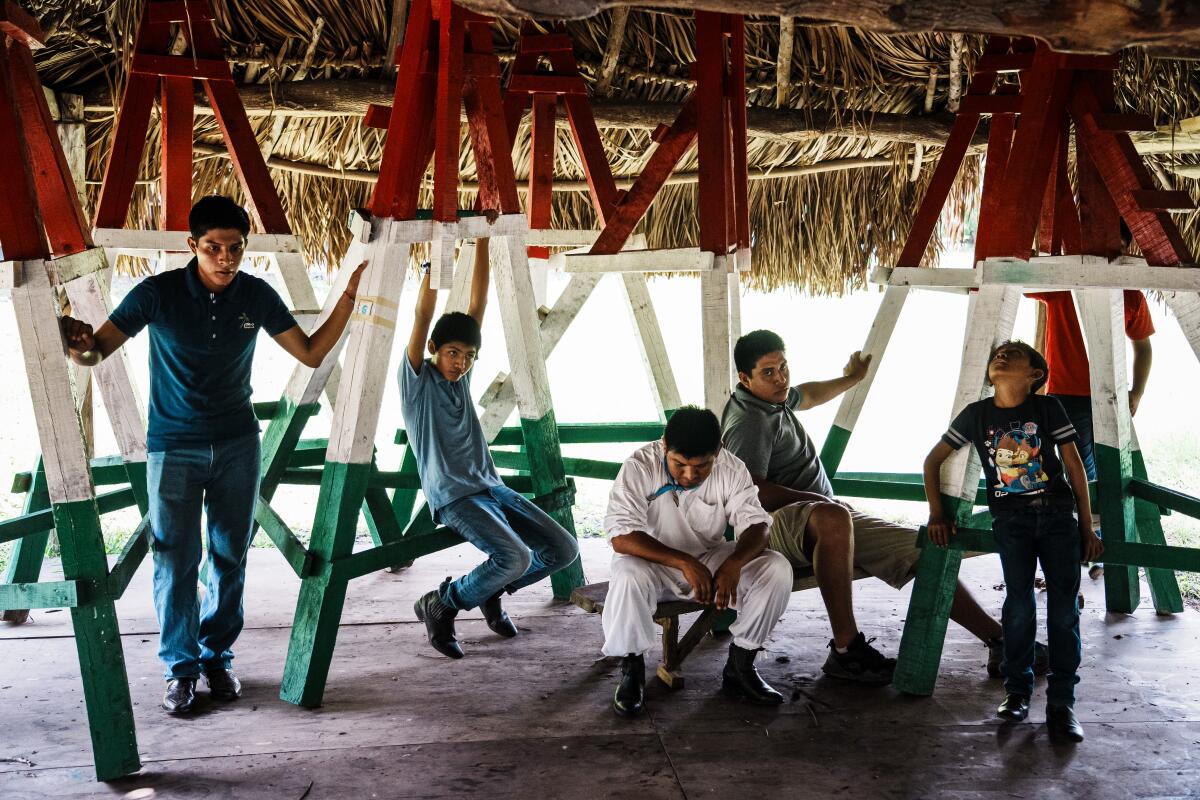
3
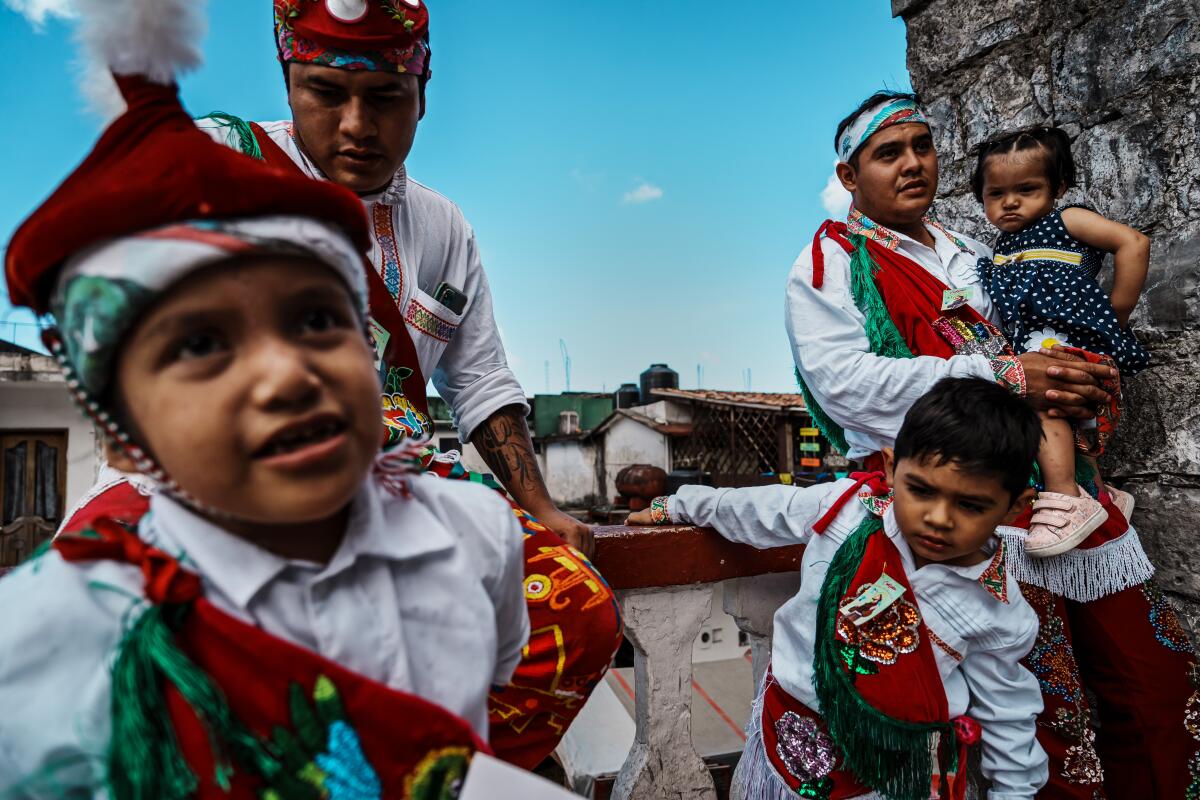
1. Children learn to fly in free weekly classes offered in Papantla in central Mexico. 2. Children gather for classes teaching students how to be voladores in Papantla. 3. Voladores Ricardo García, left, and Carlos Fernández, right, are joined in Cuetzalan by children also dressed as voladores.
“It’s lethal, yes, but it’s something that calls to you, something that identifies me as a Mexican,” he says, “something where I can say with pride, ‘This is what I am.’”
Mountain roads winding through the state of Puebla lead to Cuetzalan, a municipality of 51,000 where most live in poverty and speak the Indigenous language Náhuatl. It has proudly rejected Walmart and mining concessions critics call “projects of death,” instead boosting its economy through tourist excursions to waterfalls and caves.
It’s hard to know when the voladores first arrived here, but the ritual they sometimes call the “dance” has become embedded in the city’s identity.
There are 120 voladores, forming groups often made up of families. A weekend outdoor market sells volador-themed keychains and little poles with figurines of fliers hanging by threads. Not too far from the Volador Inn, a restaurant stages the flight from a metal pole.
Cheerful flute music fills the main square on weekends, when voladores collect tips after flying. But one tradition has not changed: replacing the skyscraping tree trunk in the town square each year is a feat that requires dozens of volunteers and brings many in the town together.
Ricardo‘s father, Rufino García, began flying at 19 when an older volador invited him to try.
Rufino was hooked. There was nothing like the adrenaline of flying. He wasn’t scared since he was used to climbing trees to get firewood.
The woman he was dating, Enedina, worried about his safety, but she was proud to sew his first volador uniform. Enedina lost her nervousness and married into the volador life.
Rufino didn’t want their sons to become voladores, but it ran in their blood. His oldest, also named Rufino, flew at 15, then Jesús and Ricardo.
“We’ll be right back,” the brothers would tell their mom on weekends, carrying a frame and rope to a tree they had cleared of branches in order to practice.
The brothers grew up in Cuapech, a neighborhood in Cuetzalan with many voladores, and lived down the road from Jorge Baltazar, the man who had invited their father to fly. Baltazar, who says his four daughters were the first voladoras of Cuetzalan, had even erected a shorter volador pole to teach children the art.
1
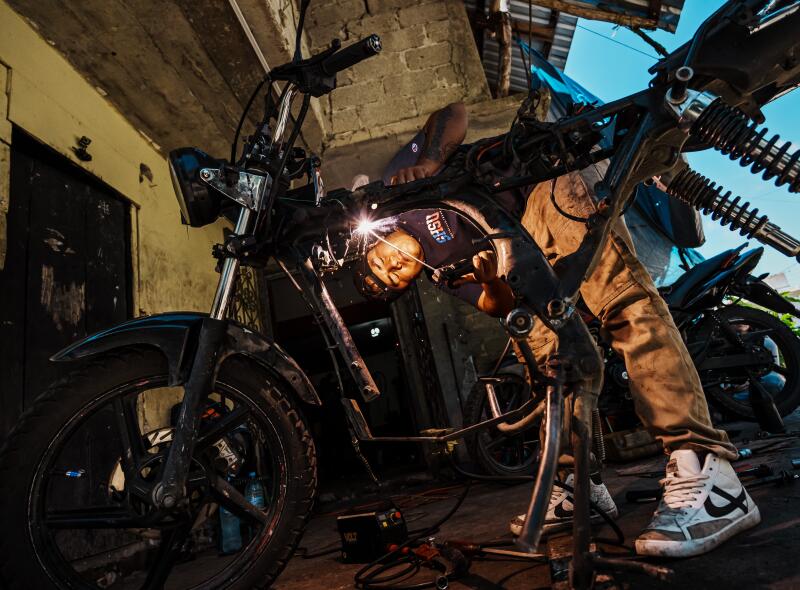
2
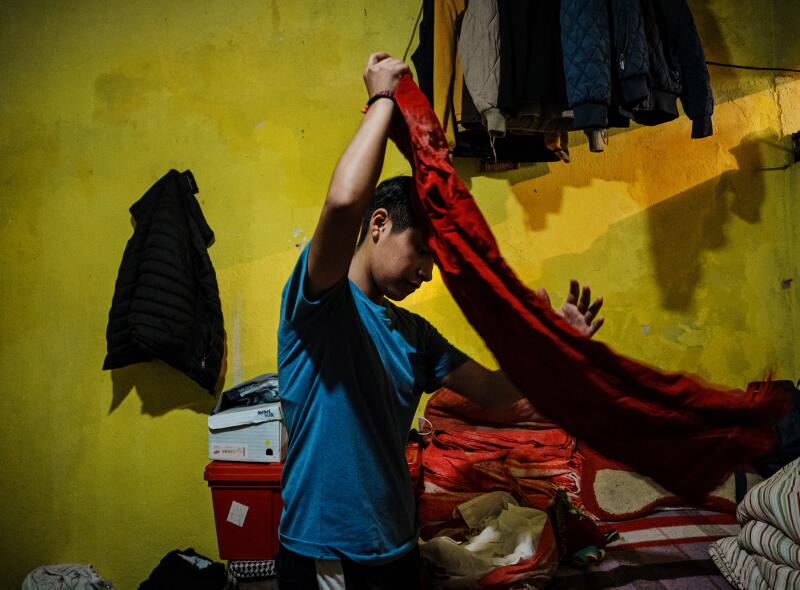
3
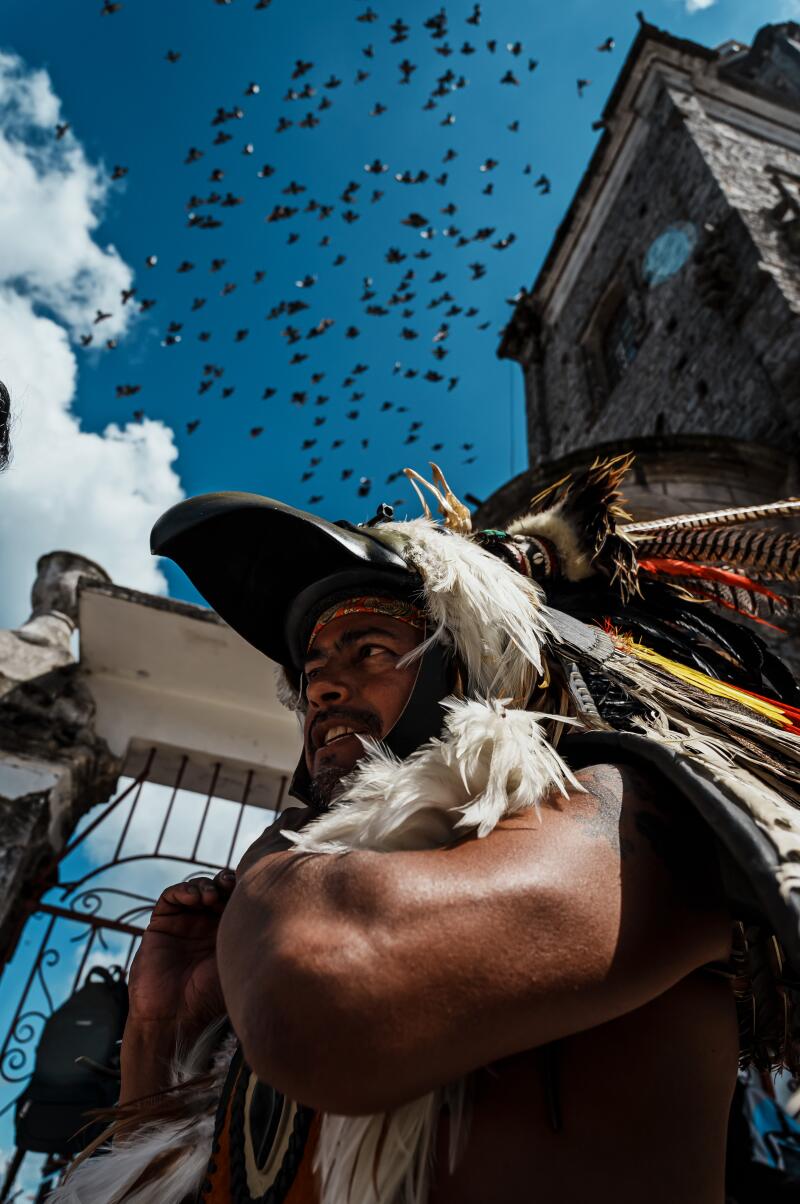
1. Ricardo García, a volador who repairs and maintains motorcycles for a living, has been flying for 10 years. 2. Xochitl Salas de la Cruz folds her volador attire at home in Cuetzalan. 3. Arturo Díaz, a volador preparing to mount the pole in Cuetzalan, recalls that his introduction to the ritual years ago was “a disaster.” At the top of the pole, he was paralyzed with fear.
One of his recent female students is Xochitl Salas de la Cruz, an athletic 17-year-old who lightheartedly recalls how her brother once accidentally spilled hot sauce on her headdress. “I feel free, I feel at peace, I feel calm,” she says of flying. “In that moment, I forget about everything, school, all of it. It’s only the dance.”
She’s two years older than Ricardo was when he started to fly in the church square. Until then, he would help his father tend cows while his brothers were off flying.
“In my family,” he said, “I felt less.”
Then, on Christmas Eve when he was 15, it was finally his turn. He crossed himself and climbed the pole in Cuetzalan’s square, pausing to rest as he made his way up.
“I’m behind you, go calmly,” another volador encouraged him.
At the top, Ricardo couldn’t help smiling as he took in the view of the cloudy day. As he fell through the air, he let himself go. He heard the creak of the platform turning with the weight of the voladores as the rope unspooled counterclockwise, and the music of the drum and flute. He kept his eyes open as he hung upside down and opened his arms, feeling the pull of the rope around his waist.
He spun more slowly as he neared the ground. About three minutes after he took flight, he turned himself right side up and touched down on his feet.
Now flying is just a part of García family life. Outside Rufino and Enedina’s house, a chunk of a wooden pole with steps still nailed in lies in the grass. Inside, near the dining table, slices of old volador poles double as stools.
Enedina proudly shows a tarp she had made with a blown-up photo of her three sons and husband in volador uniform, and on her cellphone is a photo of Ricardo as a toddler dressed as a volador. Her oldest son, she gushes, plays the volador flute “beautifully.”
She sometimes worries about her sons when they go on long drives to fly in other cities. She knows they’re experienced, but that some things are out of their hands.
“Only God knows if their time is up,” she says.
Her husband no longer flies because of shoulder injuries from previous heavy lifting jobs. But when the couple renewed their marriage vows several years ago, he dressed as a volador.
::
Much is unknown about who the first voladores were.
But based on archaeological findings, experts believe that the ceremony goes as far back as 2,500 years ago; images from a 16th-century codex suggest it may have been associated with human sacrifice. Some early depictions show voladores dressed as birds, perhaps to personify gods.
Alessandro Lupo, an Italian ethnologist who has studied the voladores, ventured that the spectacular nature of the ritual allowed it to survive the Spanish. It’s also an extraordinary way to prove your religious devotion.
“We can all pray the Lord’s Prayer, Ave Maria,” he says, “but climb a 100-foot post and jump headfirst when you know that if you fall you die.”

Arturo Díaz, a volador from Cuetzalan, says that the flying voladores evoke the Earth’s movement around the sun, which is represented by the fifth volador dancing on the pole. That volador, he says, “offers a prayer so that energy, everything that makes up life, comes down from the sky.” Baltazar says that the voladores represent the four cardinal directions.
In Cuetzalan, voladores’ practices have come and gone over the years. Today, the voladores wear red, to represent blood and life, some say, and feathered headdresses to evoke birds. But the old custom of sexual abstinence and purification in a river before cutting a new ritual tree has fallen by the wayside.
Replacing the palo volador — which voladores say represents the connection between the underworld, human world and celestial world — is one tradition that in Cuetzalan, at least, the voladores are committed to keeping.
One morning in August, the García brothers and their father set out from town with about two dozen other voladores and many more volunteers. The group, almost all men, ride in cars and in the back of pickup trucks to a forest about an hour away to retrieve the tree already selected for the ritual.
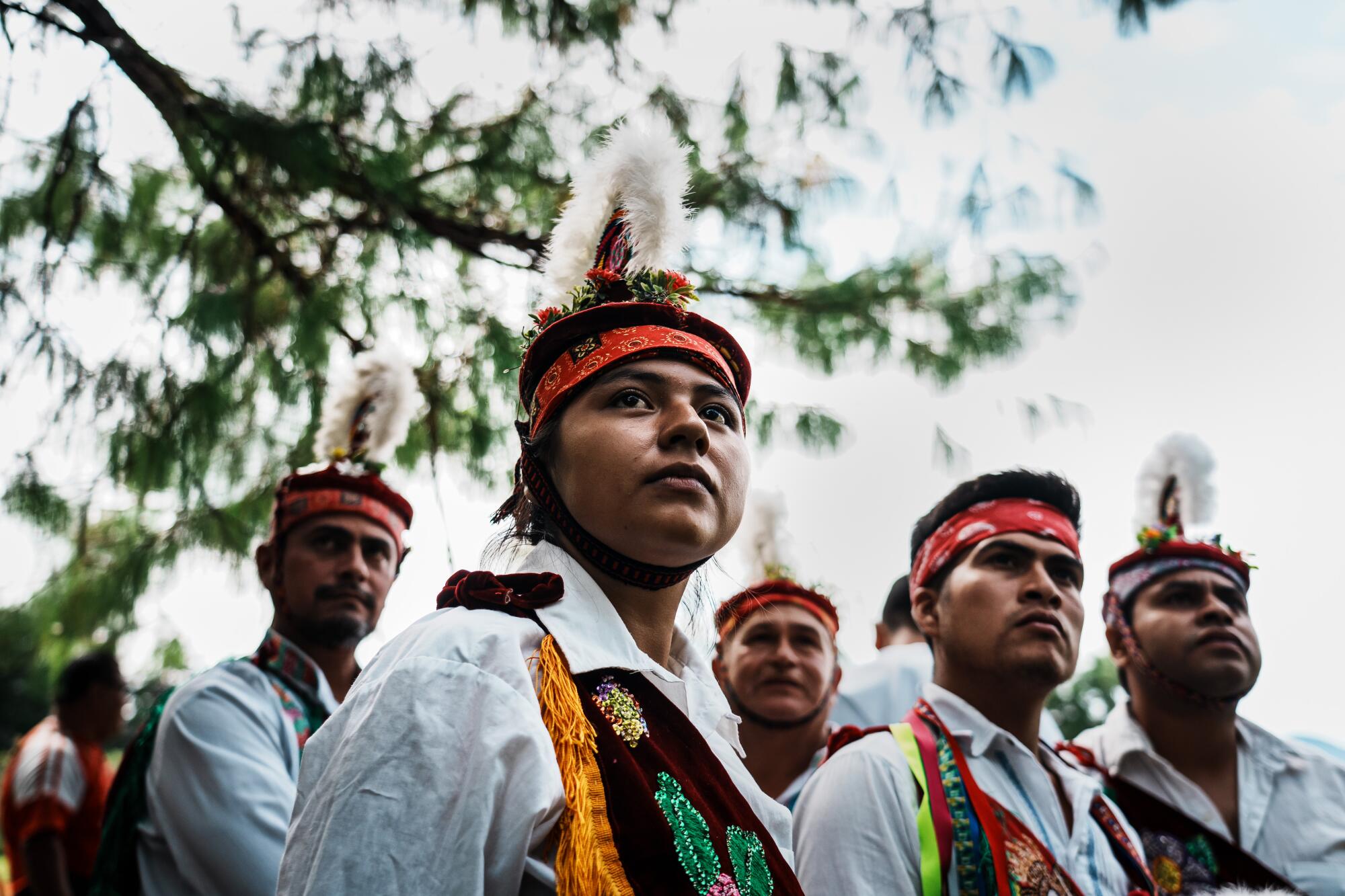
There, walking for about 10 minutes on a rugged dirt road in the misty mountain air, one man cheerfully grumbles that the tree is too deep in the woods and would be hard to pull out.
They reach a clearing and gather in a half circle as two priests celebrate a Mass a few feet away from the tree, blessing some of the materials the voladores would use this day: flowers, candles, an electric saw.
The voladores then form a line. One runs a goblet with copal incense up and down the bodies of his colleagues. They move in single file toward the tree as a flute plays. Each volador takes a turn walking around the tree with the incense and flowers, and sprinkling it with holy water and aguardiente.
When the cutting begins, about 60 men grasp long ropes to ensure the tree will fall in the right direction. “Pull, pull!” they yell. They rush forward as the tree falls, its crash muffled when it lands on smaller trees.
The rest is more teamwork — and grunt work. The tree’s branches are sawed off and the trunk is dragged away by a bulldozer. It takes several hours, and a lot of shouted directions and playful curses, to navigate the tree through the forest.
1
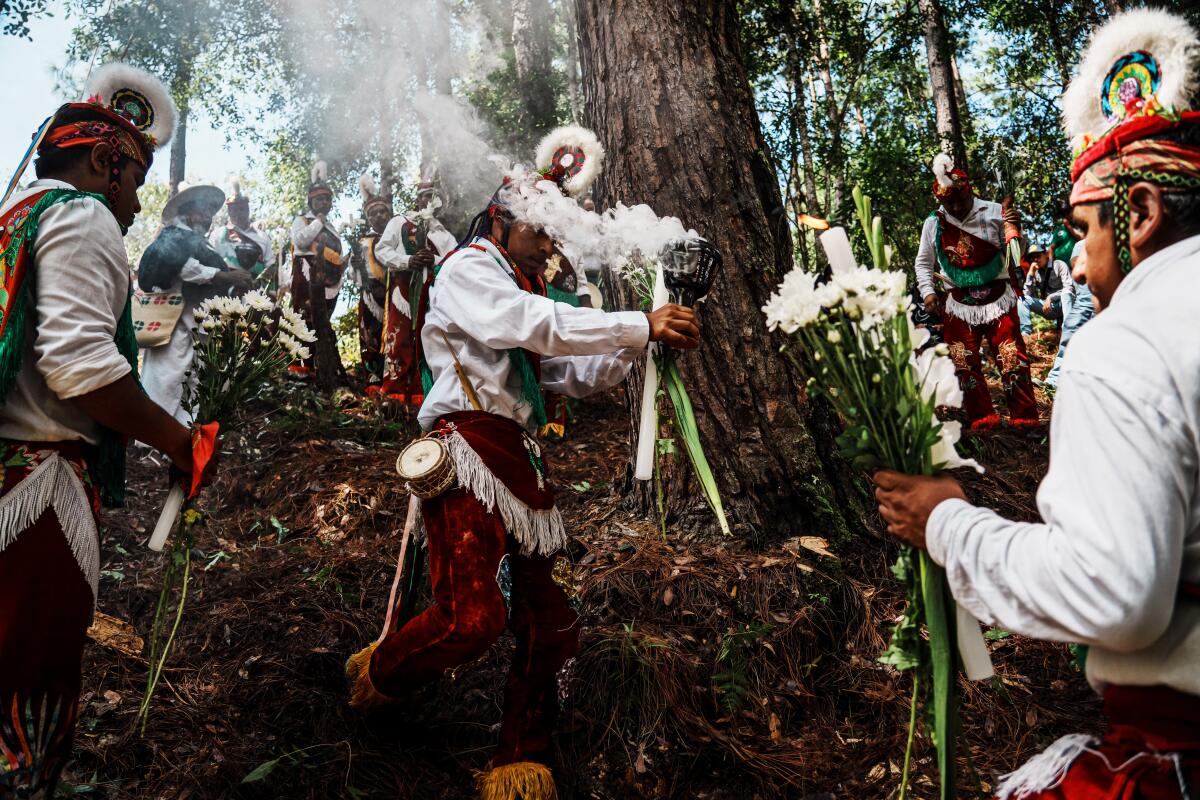
2

3
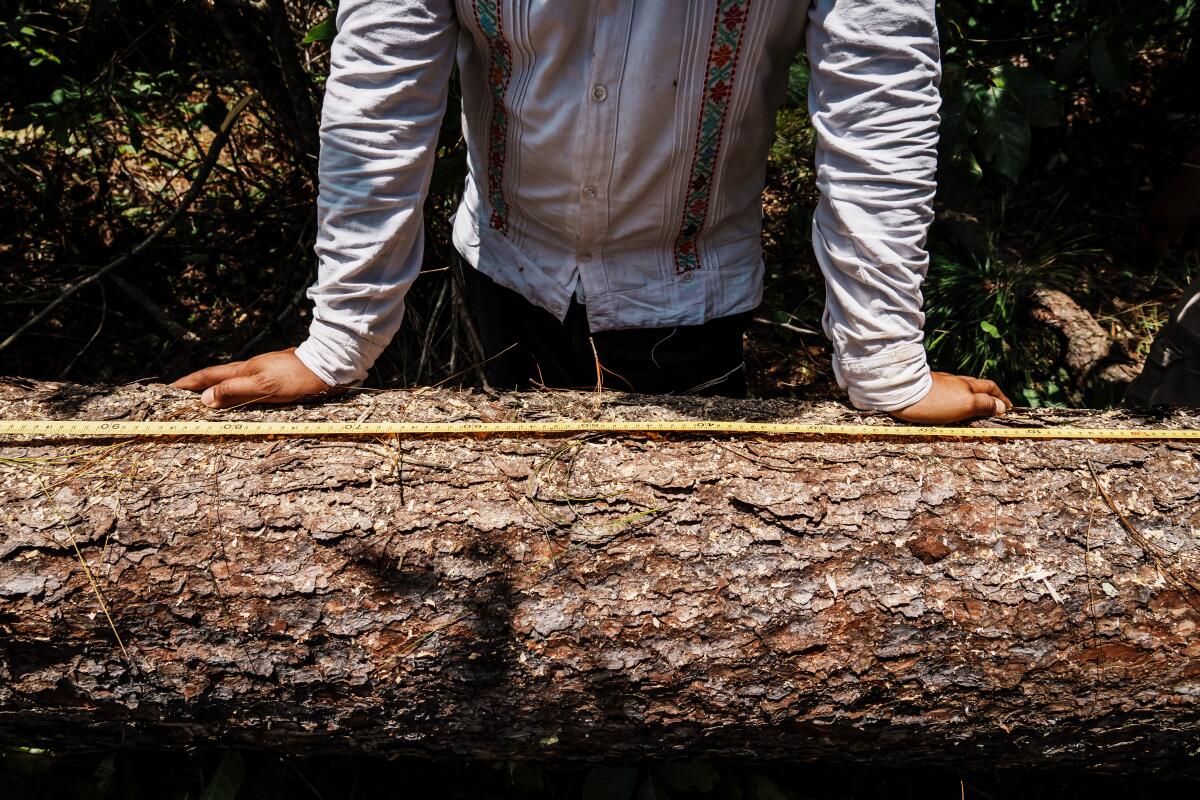
1. A volador carrying incense walks around a tree that will be cut down and erected in Cuetzalan to serve as the new volador pole. 2. Men grasp long ropes to ensure that the tree will fall in the right direction. 3. Arturo Díaz checks the length of the tree destined to be erected in the town square as the volador pole in Cuetzalan.
Previous years had been more difficult, said Díaz, who wears a bandanna to block out sweat. Once, the tree broke as they were hoisting it on the truck and the entire ceremony had to be done all over again.
Ricardo and his brothers help load the newest tree onto a dump truck, securing it with belts and rope. As the sirens of a police escort blare, the caravan of cars and the tree make its way down the curving mountain roads and into town, where local news stations and hundreds of residents wait in the main square.
::
The García family is lucky — ropes have gotten tangled, but neither the father nor his sons have ever had a serious accident.
Fatal falls across Mexico make newspaper headlines. In the tight circle of voladores from Cuetzalan, when someone falls, everyone hears about it. That was the case with José Luis Hernández.
When Hernández, 25, began flying, following in the footsteps of his relatives, he felt like he had discovered a new crush. It was like “when you meet someone you like,” but more powerful.
In October 2021, he traveled to a town a few hours away from Cuetzalan to dance in a Day of the Dead festival. The fliers noticed that the ropes seemed wet but waved it off.
Hernández had only been flying for a few seconds when his rope broke. He plunged to the ground, suffering fractures on his feet, legs, left hand and face.
He spent a month in the hospital, where nurses told him he had a guardian angel. Then it took another month before he could take his first steps.
1
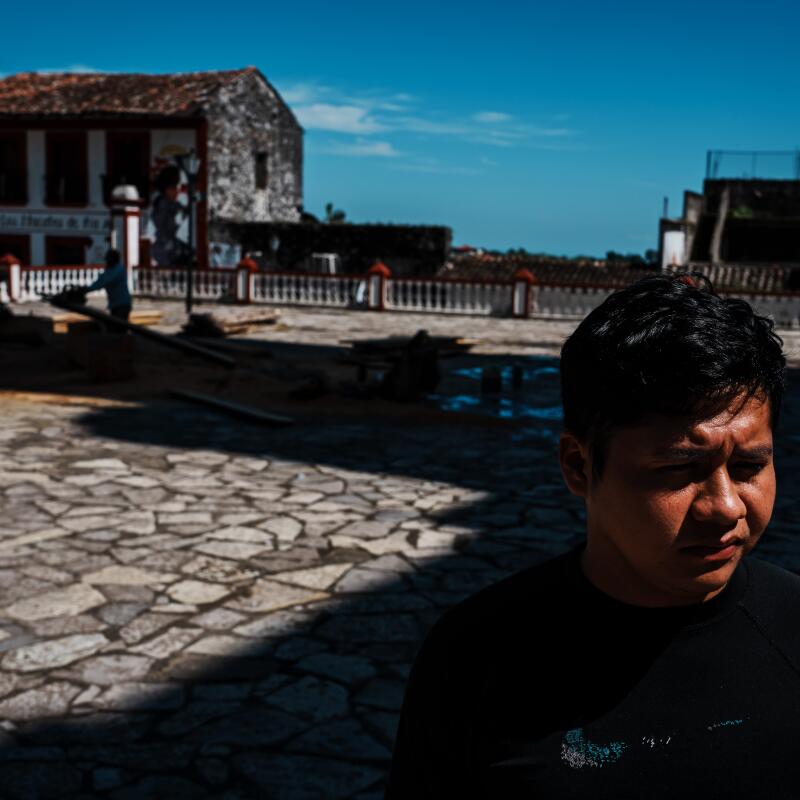
2

1. José Luis Hernández, standing in the shadow of the church in Cuetzalan, was once badly injured when his rope snapped and he fell shortly after he began the flying ritual. 2. Ricardo García, left, with his cousin, center, at his parents’ home, where slices of old volador poles serve as stools.
For almost two years, not wanting to worry his family, especially his mother, Hernández didn’t fly. Instead, he handled logistics and social media for his voladores group, and as a tour guide in Cuetzalan answered an “infinite number of questions” about the ritual.
But he longed to return to the pole.
“The dance is supposedly a dance to the cosmos, the universe,” he says. “It’s about finding yourself.”
In September, during a religious holiday, he finally did, returning to the adrenaline and the connection he feels to nature in the air.
“It was like the first time, the same feeling, the same energies, the same fear, everything,” he says.
The Indigenous roots of the ritual are partly why voladores from Puebla believe the government should do more to support them.
They are petitioning the state to recognize their art as part of Puebla’s heritage; they conducted a census that so far identified more than 400 voladores in the state. They hope recognition comes with a plan to protect the ritual, including financial support to pay for voladores’ uniforms and help those who are injured while performing.
Voladores across Mexico recently formed a national council to preserve their ritual, which was recognized on UNESCO’s world heritage list in 2009. They also want states with volador communities to declare the ritual part of their heritage, something only Veracruz and San Luis Potosí have done so far, and are fighting back against what they see as exploitation of their image.
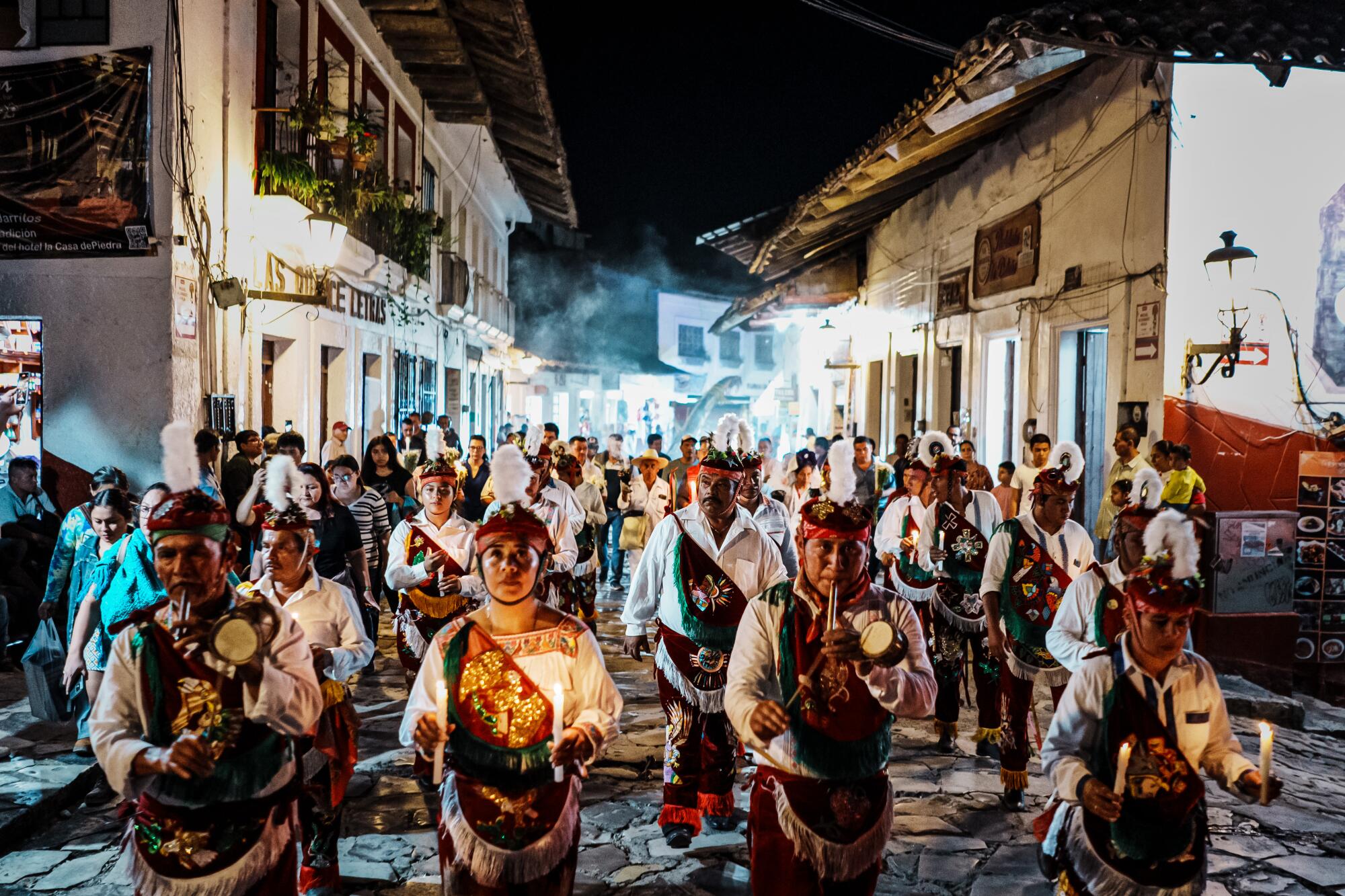
In 2022, for example, a loan company issued a public apology to voladores after it faced backlash for a commercial that claimed that the number of times voladores fly around the pole and a person’s first loan “both generate zero interest.”
Voladores also grapple with how much they should seek to commercialize and institutionalize their culture.
Many say that there’s nothing wrong in asking for a tip after performing the ritual or earning a contract to perform abroad, pointing to the money they invest in buying their uniforms.
“We need to maintain a balance between not crossing the line of reaching full commercialization of the dance, but we also can’t receive nothing for the days we put in, for all our effort,” says Díaz.
Díaz’s own introduction to the ritual was “a disaster.” Once on the frame, he was paralyzed with fear. When it came time to launch himself, he was delayed by an issue with his rope and another dancer finally grabbed both of his hands and dropped him.
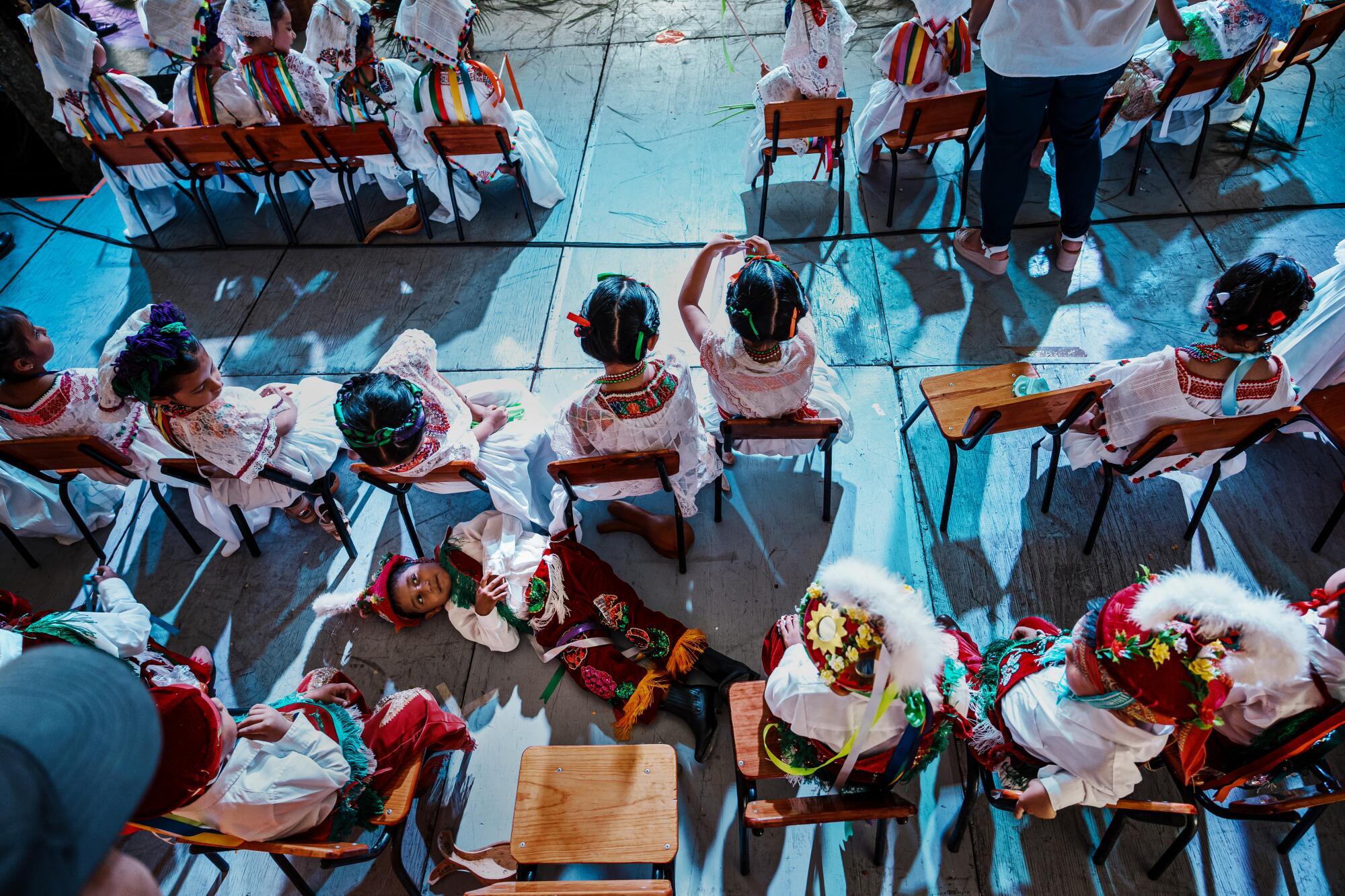
As Díaz recalls, he “started to spin many times over my own axis. I couldn’t see anything. I started to get dizzy, and said, ‘I’m going to throw up.’”
After a while, though, he was flying smoothly — and although he touched down red-faced, fell in love with the ritual art.
Díaz says that a volador school in Papantla that offers free weekly classes to students can be a model for Cuetzalan, but that he’s also wary about institutionalizing the ritual to the extent that it loses its purity.
“The ritual ceremony of the voladores is not in danger of extinction in its physical form. Every time there are more kids, more youth that participate,” Díaz told attendees at a voladores convention in Mexico City this summer. “What is in danger is the true essence of the ritual ceremony.”
Baltazar notes that people often thank voladores for keeping the tradition alive. “People approach you,” he says. “The respect they have for you, the admiration. People say congratulations, how wonderful, how good that it hasn’t gotten lost.”
::
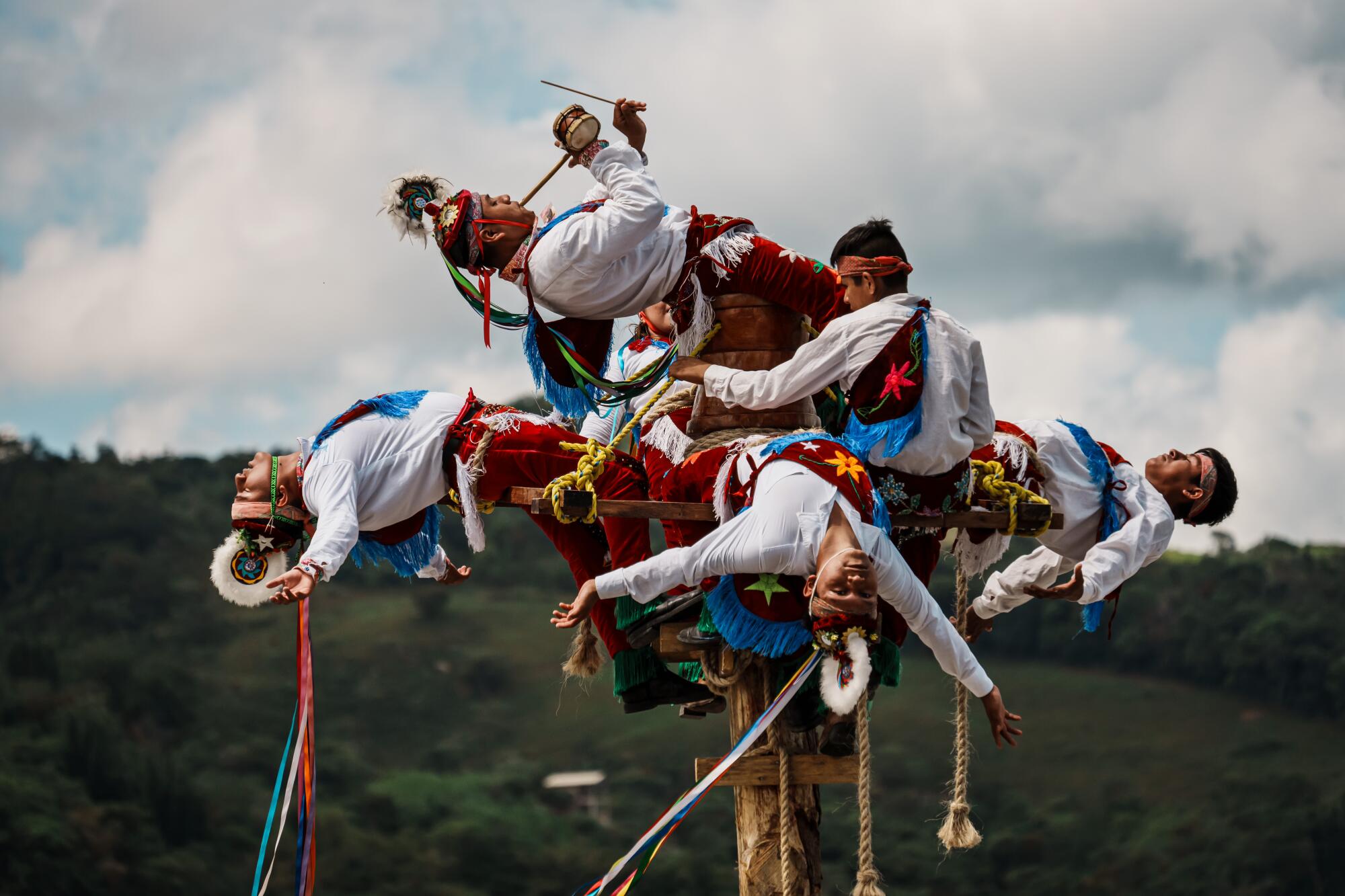
Ricardo climbs up with his brothers in a group of eight voladores for a more complicated, and even more dangerous, maneuver than usual. Seven sit crowded elbow-to-elbow on the frame while one stands on the pole and dances.
Although Ricardo had been spending much of his time out of Cuetzalan on a construction job, he couldn’t miss returning home recently for the town’s biggest event, a nine-day festival honoring its patron saint, Francisco de Asis.
On a large stage inside a packed amphitheater, a group of kindergartners attempts to stomp in unison around a small volador pole while Baltazar plays the flute. Parents clap as his 7-year-old grandson and granddaughter fly.
Nearby, Indigenous dance groups spread out on the church square as voladores take to the newly erected pole. The fliers’ flute can barely be heard over the clash of violins, drums and guitars below.
As soon as one volador group scales the pole, another prepares to go up, dancing around the base. On the frame 100 feet up, voladores take selfies and flash peace signs. Rockets explode and drones buzz as the voladores spin through the air.
A wide-eyed little girl watching with her father from the church steps points skyward. “Dad, dad, dad, dad, look, dad!” she says.
A 23-year-old voladora who hadn’t flown in years waves at her 2-year-old daughter from the air.
When Ricardo and the other seven are ready, four of them plunge backward to take flight, the colorful streamers and feathers attached to their headdresses rippling in the wind. When they are about three-quarters of the way to the ground, the other four voladores, including Ricardo, begin inching their way down the same moving ropes, stopping halfway to strike acrobatic poses.
Even when it starts to rain, voladores continue to fly, landing on the wet cobblestones with wide smiles. One pats another on the back. The crowd applauds. “Let’s go!” a man shouts.
And then, without wasting a moment, another group climbs up.
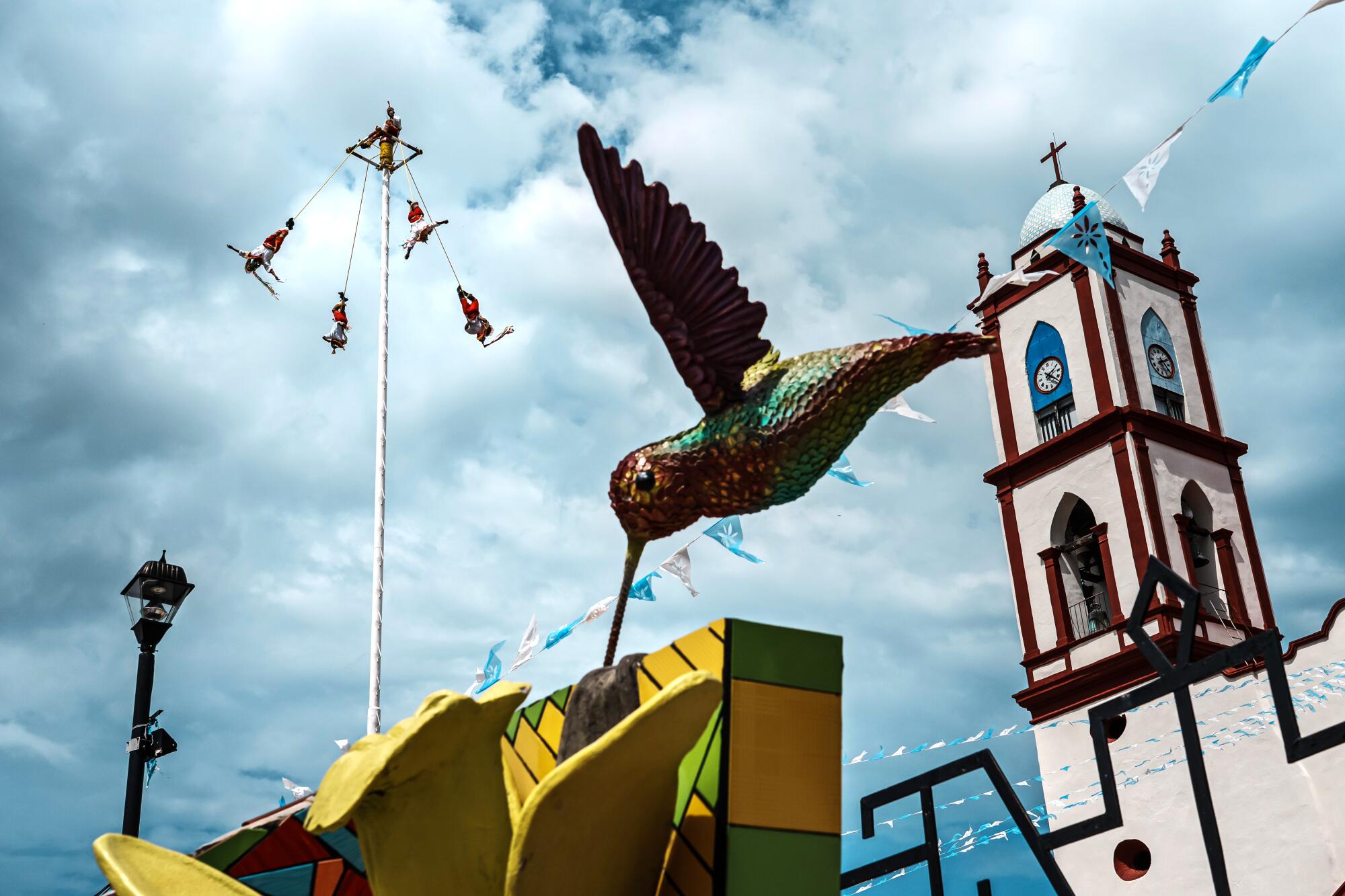
More to Read
Sign up for Essential California
The most important California stories and recommendations in your inbox every morning.
You may occasionally receive promotional content from the Los Angeles Times.
